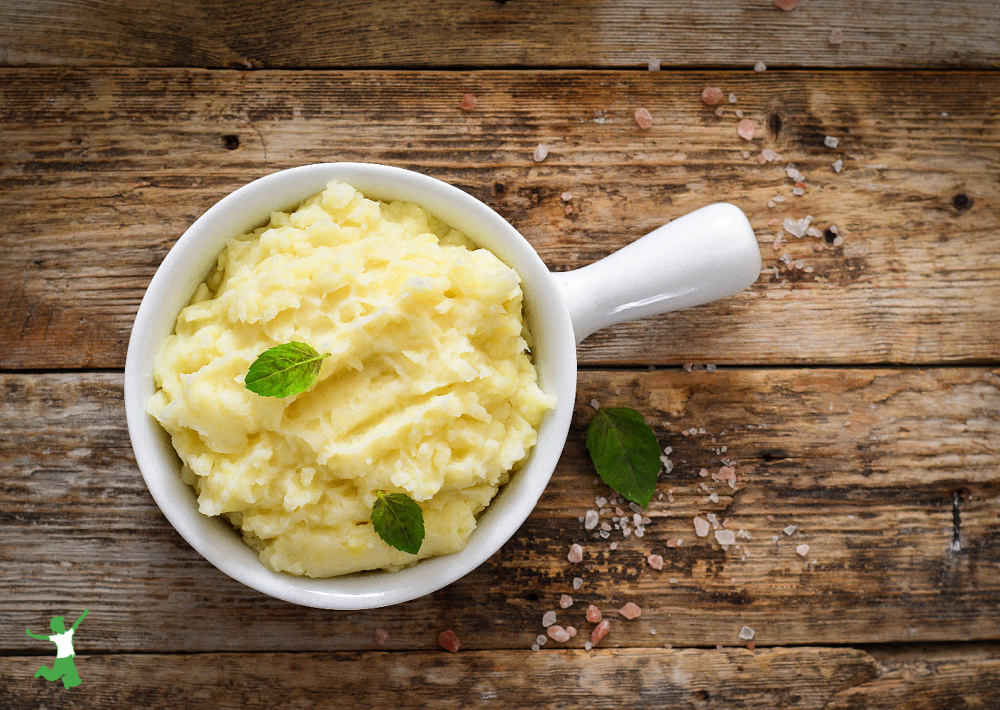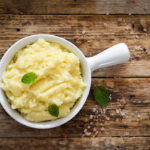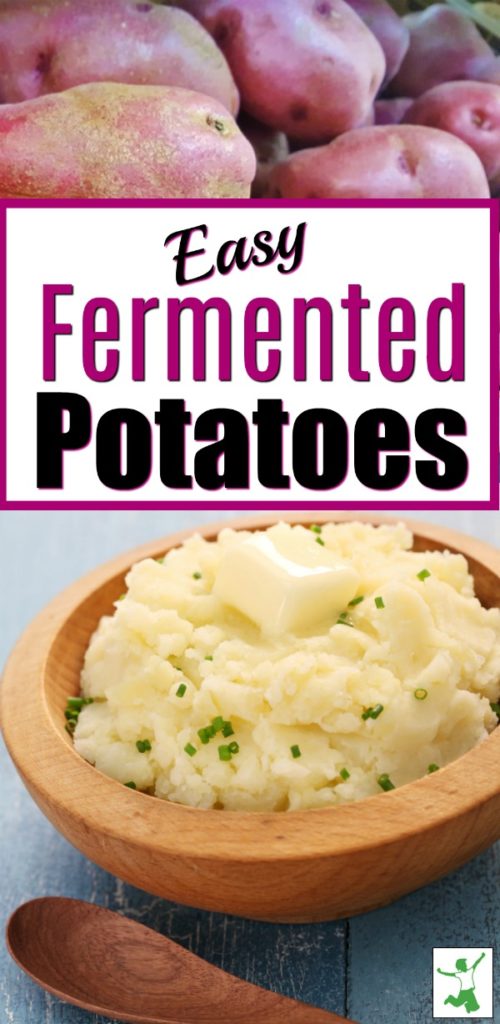Table of Contents[Hide][Show]
Traditional method for fermented potatoes as an enzyme-rich, cultured side dish that adds probiotics and resistant starch to the diet.

Is there anything quite as satisfying as mashed potatoes with dinner? I just love all forms of potatoes… baked, fried, mashed, even boiled!
This recipe provides a traditional method (with video how-to) for making fermented potatoes to add to your spuds repertoire.
Why would you want to make cultured potatoes in the first place? Because, unfortunately, the starch in potatoes is really not all that easy to digest for many people.
Especially these days with so many people suffering from digestive complaints of all kinds, starch can be a real pain…quite literally!
Potatoes are also nightshade vegetables, so lightly culturing them can help with any issues for those who are sensitive.
The problem is with the starch molecule itself. Each one is quite complex…comprised of hundreds of mono-sugars connected in long, branch-like strands.
It takes much digestive work to break down the starch molecule and, as a result, much of it goes undigested in most cases.
For those with an imbalanced gut, the undigested starch is the perfect food for pathogens and they grow and produce toxins that cause a variety of unpleasant symptoms in susceptible individuals.
Easy-to-Digest Cultured Potatoes
If you enjoy potatoes but find that they trigger digestive or autoimmune symptoms, it might be worth it for you to try your hand at fermenting them.
I prefer Yukon Gold as it seems to make the tastiest dish! Red or purple potatoes are also amazing.
If you are coming off the GAPS, AIP or SCD diets and reintroducing resistant starch to your diet after a period of gut healing, fermented potatoes would be a great first step.
While resistant starch is reduced during cooking, the bonds reform when the potatoes are cooled and these “new resistant starches” remain even if the dish is reheated before eating! (1)
We like this dish in our home to simply add that probiotic element to a meal of primarily cooked foods. Adding enzyme-rich, live food to your meals is nothing short of miraculous for boosting immunity and improving nutrient absorption.
If you’ve been wanting to make a fermented dish at home for the first time, this would be an easy and delicious one to start with!
The video demonstration included with the recipe below shows how to make probiotic potatoes using the Nourishing Traditions method.
If you are not eating white potatoes, feel free to substitute sweet potatoes instead.
Dairy-free? Try this fermented sweet potatoes recipe that uses sauerkraut juice instead of yogurt as the starter.

Fermented Potatoes Recipe
This recipe for fermented potatoes is an enzyme and probiotic-rich side dish that adds resistant starch that is more easily digested and shown to reduce belly fat.
Ingredients
- 4 cups white potatoes preferably organic
- 2 cups whole milk yogurt plain, preferably organic
- 1 Tbsp sea salt
Instructions
-
Peel the potatoes. This greatly reduces the chances of fermentation mold. Bake or boil potatoes and then mash them in a large glass bowl. Do not microwave.
-
With a handheld mixer or food processor, blend well with yogurt and sea salt once the potatoes are warm and no longer hot.
-
Cover with a clean, cotton cloth and secure with a rubber band. Leave the covered bowl on the counter for 2 days and then refrigerate. They will last about a month.
-
Serve with steak as an enzyme-rich side dish or with any meal where potatoes work well.
-
You may reheat cultured potatoes on the stove before serving, but take care not to warm them too much or enzymes and probiotics will be lost. Keep below 118 °F/ 48 °C.
Recipe Video

(1) Eat This Carb and You Won’t Gain Weight








Yup! I haven't gotten to the "switching to raw milk" thing yet, so I make stuff with pasteurized milk all the time. Fortunately I have access to what I consider to be the second-best thing to raw milk: Cedar Summit Farms near the Twin Cities has non-homogenized whole milk from grass-fed cows which they pasteurize (NOT ultra-pasteurize) right on the farm. It works great in every NT-related thing I make.
I made fermented beets this summer, and it seemed odd to cook them first, and since they were tiny I just fermented them raw. As it turns out, they are quite tasty thinly sliced on top of a salad. I love that there are multiple right answers to this stuff.
I would also add that pasteurized milk can still be cultured back to life with a yogurt or kefir culture. The process is similar – the yogurt/kefir culture feeds on the lactose in the milk and the milk ferments into yogurt or kefir depending on what starter culture you used.
Hi newhomeeconomics, yes – the yogurt is live and full of probiotics/enzymes and these beneficial bacteria feed on the starch in the potatoes and the food is fermented in this manner.
I'm having a hard time understanding how cooked foods ferment. I read Wild Fermentation and all, but it just seems like the natural enzymes, etc. in raw food are lost when it is cooked. Is that the reason for the yogurt?
Hi Nance, squash is not as starchy as potatoes or even sweet potatoes, but it should work fine.
Just wondering…could/should this be done with winter squash? They have a similar profile, don't they?
Wow, I never ever thought that potatoes could be fermented. Of course I'm still new to most of this but wow, learn something new everyday! I will have to give this a whirl when I have more yogurt.
Hi Barbara, I don't see why not. I've always peeled them first, but give it a go. It would probably be fine.
I was thinking to air fry the potatoes with skin rubbed in olive oil and salt…then slice and scoop out the potato for fermenting while still having those crispy skins to enjoy.
Sarah, is it necessary to peel the potatoes? I usually make my mashed potatoes with the skin on as well as adding an onion…. can I do the same with the fermented potatoes?
I'm definitely going to be serving these at Thanksgiving instead of traditional potatoes!
THANK YOU! This is amazingly helpful. I love your videos.